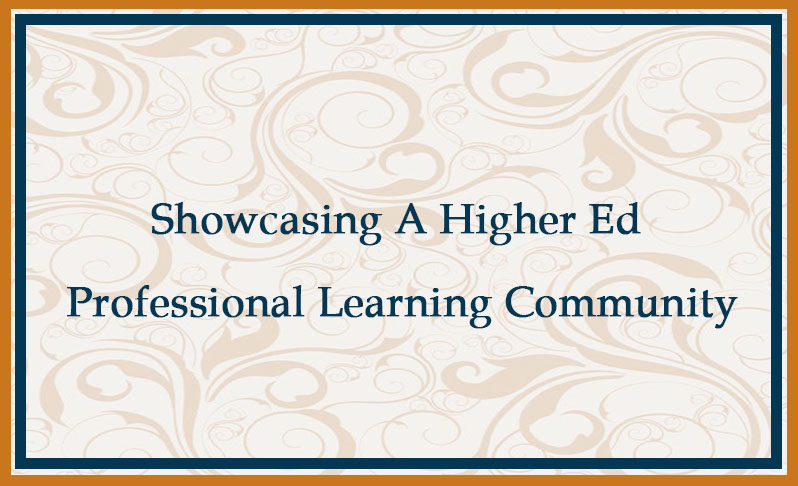Professional Learning Communities (PLCs) already play a large part in our faculty development program. Usually the semester after they finish, PLCs are invited to present a workshop in our Teaching & Learning Center wherein they provide faculty with some of their discoveries from the previous semester. In a normal semester we sponsor a minimum of three PLCs, but we find one of them gets shorted in the process. Our Creative Community (something we wrote about in a post called “A Third Type of Community”) has taken it upon itself to produce a published novel twice a year, but since most of the campus isn’t interested in becoming creative writers, how do we offer them a platform for publicizing their huge accomplishments?
A second problem is a way of publicizing one our newest services. A couple of years ago our parent organization, the Noel Studio for Academic Creativity, hired a Technology Coordinator. While the position came with many responsibilities—e.g., maintaining our unit’s website, repairing and purchasing need technology, and helping others set up technology for presentations—our new hiree was ambitious and started a program with student help he called Media Consultants. Over the past year, Jason helped numerous faculty with technological solutions to their problems. However, while we knew of what the Media Consultants accomplished, the rest of the campus didn’t, so how could we publicize this valuable service?
Related Reading: How to Assess Professional Learning Communities
Using Milestone Events to Unify Faculty Development
A while back in our posts we explained how we created a unified faculty development program through a series of milestone events. Milestone events are regular occurrences spaced throughout the year on which faculty can depend. In that original post, we listed our major four events—orientations (new faculty, part-time, and teaching assistants) in August, the Provost’s Speaker Series in the fall, Scholars Week (nee Scholarship Week) in April, and the Pedagogicon in May. Typically we create and develop a theme—e.g., deep learning, high-impact practices—that runs throughout the events. Iteration serves as the reinforcing agent.
Our basic solution, then, was to create a new milestone event that highlighted the excellent work performed by Jason and his media consultants as well as the creative community. Earlier this month for the first time we sponsored our annual Showcase of Teaching and Learning Innovations.
The Showcase publicized and celebrated the accomplishments of all participants in our three PLCs, presentations from our Teaching & Learning Innovations Series, and the projects aided by the Media Consultants. In our Faculty Center, we set up stations for each group to present. Some groups merely set up posters detailing their work, while other groups elected to have a “live” poster with someone there to explain over a two-hour period what work the group performed and what results were achieved. As a result, we had presenters on everything from active learning to a pedagogical application of a new software program.
Related Reading: Creating Unified Higher Ed Faculty Development Programming
Creative Community Poster
The Creative Community poster posed quite a challenge for us. Since folks might not be interested in the intricacies of writing fiction (something hard for us to imagine), we asked ourselves what about the production of a novel might stimulate their curiosity? The answer was the process of creativity involved. As we had written both Introduction to Applied Creative Thinking (2012) and Teaching Applied Creative Thinking (2013), we were quite aware, as the titles themselves suggest, that the key was the transference of knowledge. What might interest our audience were the basic strategies of creative thinking that the creative community applied to the successful writing and publication of five novels over a two-and-a-half-year duration.
First, for the Annual Showcase, we used for a poster the cover of the group’s latest novel, Where There’s Fire (2016). Beside the poster stood an explanation of the process used to create, emphasizing values (e.g., discipline, passion, organization) and strategies (e.g., brainstorming, collaboration, perception shifting, piggybacking, glimmer-catching) necessary for five people to write between 400-500 pages in a semester. You can also find an elaborated discussion on how to emulate the create community in our Options: Constructing Your House of Fiction (2014).
Conclusion
Creating new milestone events is a method of capitalizing on a proven success through adding more iteration. In fact, while we were creating our Annual Showcase of Teaching and Learning Innovations, we decided to add a January event, the Faculty Leadership Institute, but that’s the subject of another post.
Author
 Dr. Russell Carpenter is director of the Noel Studio for Academic Creativity and Program Director of the Minor in Applied Creative Thinking at Eastern Kentucky University. He is also Assistant Professor of English. Dr. Carpenter has published on the topic of creative thinking, among other areas, including two texts by New Forums Press. In addition, he has taught courses in creative thinking in EKU’s Minor in Applied Creative Thinking, which was featured in the New York Times in February 2014. Meet Russell.
Dr. Russell Carpenter is director of the Noel Studio for Academic Creativity and Program Director of the Minor in Applied Creative Thinking at Eastern Kentucky University. He is also Assistant Professor of English. Dr. Carpenter has published on the topic of creative thinking, among other areas, including two texts by New Forums Press. In addition, he has taught courses in creative thinking in EKU’s Minor in Applied Creative Thinking, which was featured in the New York Times in February 2014. Meet Russell.



